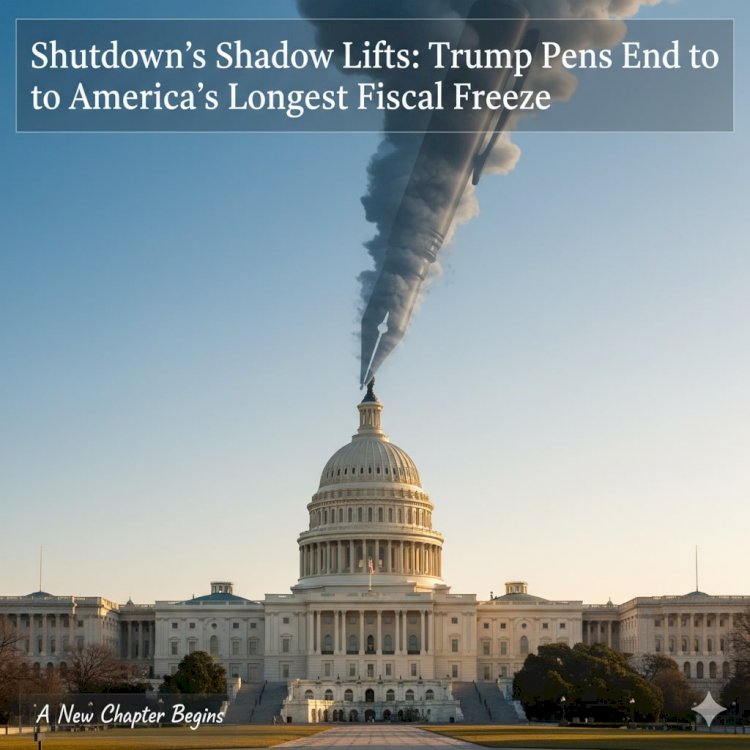Shutdown's Shadow Lifts: Trump Pens End to America's Longest Fiscal Freeze

Washington, D.C. – November 13, 2025 – In a Rose Garden ceremony laced with partisan barbs, President Donald Trump scrawled his signature on a bipartisan spending bill Wednesday night, slamming the door on the longest U.S. government shutdown in history. The 43-day standoff, a bruising saga of stalled paychecks and snarled skies, officially thawed at midnight, ushering in a fragile dawn of federal functionality just as Thanksgiving travel looms like a gathering storm.
Pen to Paper: The Gavel Falls on Fiscal Gridlock
Trump, flanked by grinning GOP lawmakers and a phalanx of federal workers clutching faded "I Want to Work" placards, brandished the legislation like a hard-won trophy. "This ends the Democrat shutdown once and for all," he boomed, his voice echoing off the White House colonnade as cameras flashed. The bill, a stopgap infusion of $1.2 trillion in emergency funds, clears the runway for furloughed feds to clock back in by Thursday morning—some 670,000 souls who endured unpaid weeks amid America's bureaucratic blackout.
The House had greenlit the measure hours earlier in a razor-thin 222-209 vote, with six Democrats defecting to join Republican ranks. Senate passage came swiftly on November 10, brokered by a trio of moderates: New Hampshire's Jeanne Shaheen and Maggie Hassan, alongside Maine's Angus King. Their compromise? A clean continuing resolution through March 2026, sidestepping deeper dives into debt ceilings or border walls. Critics decried it as a Band-Aid on a bullet wound, but for air traffic controllers grounded by exhaustion and SNAP recipients scraping by on IOUs, it was manna from the marble halls.
Furlough Fallout: Workers Reel from the Reckoning
As dawn broke over the National Mall, the human toll crystallized in quiet vignettes of relief. TSA screeners, who manned checkpoints on empty stomachs, swapped weary high-fives at Reagan National Airport. IRS auditors, their desks entombed in dust, fired up dormant computers to chase backlogged refunds. Yet the scars linger: economists peg the shutdown's GDP gouge at a cool 0.2 percentage points, a $15 billion hit to an already wheezing economy. Small businesses in D.C.'s tourism trough—think shuttered monuments and silent tour buses—brace for a rebound that's equal parts elixir and illusion.
Back pay is locked in by law, a silver thread through the fiscal fray. But for the 800,000 who toiled without checks—coasting on credit cards and canned goods—the math of survival stings. "Forty-three days of ramen doesn't vanish with a signature," muttered one Smithsonian curator, her exhibit halls echoing emptily. Across the Potomac, Virginia families who leaned on food pantries exhaled, but whispers of delayed veterans' benefits and frozen research grants ripple like aftershocks.
Skies Clearing, But Turbulence Ahead: Travel's Tense Thaw
No sector savored the reprieve like aviation, where the shutdown clipped wings nationwide. The FAA's flight cuts—4% last week, ballooning to 10% by mid-November—stranded 50,000 passengers daily, turning hubs like Atlanta and LAX into labyrinths of frustration. Now, with controllers trickling back and software glitches on the mend, airlines dare to dream of pre-shutdown rhythms. Delta's CEO hailed the bill as a "lifeline" for the holiday crush, but meteorologists eye storm fronts with wariness: will the system reboot fast enough to dodge delays?
Beyond the tarmac, the ripple effects cascade. National parks, padlocked since October 1, creak open to shutterbugs and hikers, their coffers drained of $200 million in lost fees. FDA labs, starved of funds, resume inspections on imported produce just as flu season flexes. And in rural heartlands, USDA offices dust off ledgers to disburse the November SNAP allotments that sparked lawsuits in over two dozen states—a judicial smackdown deeming the freeze illegal.
Partisan Pyrotechnics: Victory Lap or Pyrrhic Peace?
Trump's signing speech crackled with vintage fire: jabs at "radical Democrats" for weaponizing Obamacare subsidies, vows to "build the wall bigger and better" in the next funding fray. House Minority Leader Hakeem Jeffries fired back from the floor, vowing Democrats' war for expiring ACA tax credits is "just getting started." The shutdown's genesis? A Democratic filibuster in a GOP-controlled Senate, holding federal spigots hostage until Republicans blinked on health aid set to lapse by year's end. Eight Senate Dems crossed the aisle to end the siege, netting a tepid Senate vote on subsidies—but no House ironclad, no White House buy-in.
Analysts see shadows of 2018-19's 35-day impasse, but amplified: Trump's poll dip, a frosty 42% approval, underscores the political priceline. Yet he emerged unscathed on core demands, his base unmoved by the chaos. As Congress reconvenes, eyes turn to fiscal year 2026's omnibus beast—will it devour the peace, or forge a fleeting truce?
Dawn of the Debrief: A Nation Pauses, Then Pivots
By midday Thursday, federal gears grind back to life: passport lines snake shorter, loan apps ping approvals, and the Capitol's dome gleams under a crisp autumn sun. But the shutdown's specter—a 43-day testament to Washington's wiring—looms as a cautionary flare. With debt ceilings circling and midterms two years off, the ink on this bill dries fast. America, back at work, wonders: how long before the lights flicker again? For now, the hum of normalcy is symphony enough.

 content-team
content-team 


















